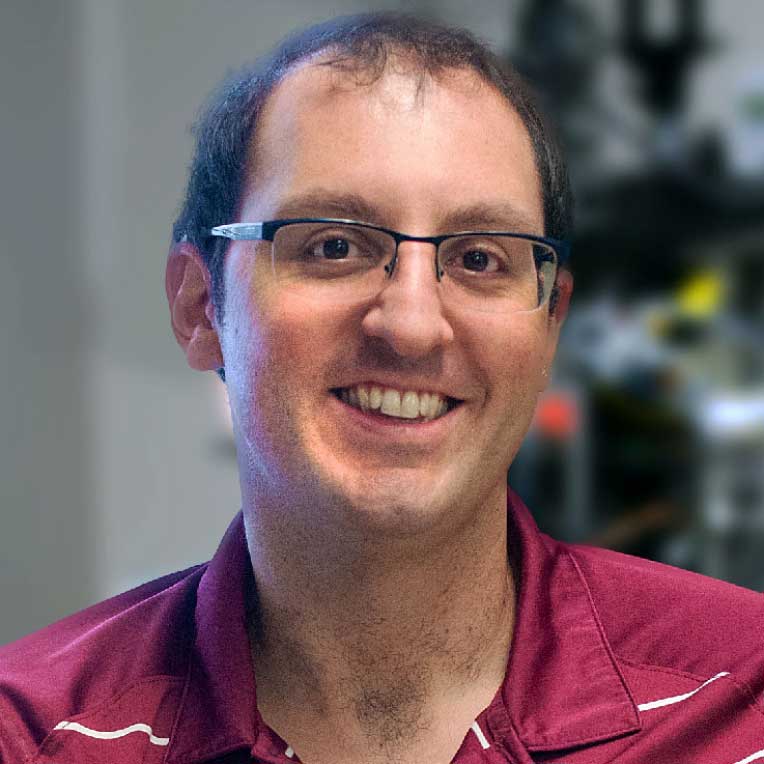Biography
Dr. Douglas Storace didn’t think he was particularly curious as a child. He grew up in Connecticut in what he describes as an average family. He developed an interest in music and studied piano with a classically trained pianist. Dr. Storace didn’t know he wanted to be a scientist back then, but his early focus on music later translated into a kind of curiosity that helped shape his research interests.
Dr. Storace graduated from Brien McMahon High School in Norwalk, CT and pursued his bachelor’s degree at the University of Connecticut. He recalls that his study skills weren’t as sharp as they needed to be when he entered college. Looking back, Dr. Storace notes that things began to click when he started playing music in a more serious way. Music forced him to “learn how to learn,” and it unlocked a question: Why do people like music? Around sophomore year, Dr. Storace decided to change his major from engineering—his father’s profession—to psychology.
Although Dr. Storace currently leads a neuroscience research group, he had never considered studying the brain until he took a class taught by Heather Read, a professor of psychology at UConn. One day she gave a lecture about how the visual part of the human brain is organized. It fascinated him. He joined her neuroscience lab where he pursued a PhD.
As time went on, Dr. Storace’s reasons for becoming a scientist evolved. He was motivated by a sense of purpose and early successes in his investigations. Scientists had already identified the part of the brain’s visual system believed to

be involved in object localization (where it is) and object recognition (what it is). His advisor really wanted to find the equivalent to this visual system in the auditory system. Part of his thesis involved mapping out this area. He and the research team found the part of the cortex that was involved in different parts of sound processing. He was excited about the discovery because the team found a way to distinguish these parts using gene expression, which was novel at the time.
Today, Dr. Storace serves as a faculty member in the Department of Biological Science at Florida State University. There, he and his team pursue key questions of how humans perceive using the mouse olfactory bulb as a model system.
“I wanted to be part of something bigger. I feel like that might have been a driving force. I was also driven by an interest in studying the brain. It's hard to get a PhD in science, but when you see some successes, you realize there's a rhythm that you can enjoy. You collect data, you analyze data, you write it up for a conference or a paper. It has a nice rhythm to it.”
– Dr. Douglas Storace

Biography
Dr. Douglas Storace didn’t think he was particularly curious as a child. He grew up in Connecticut in what he describes as an average family. He developed an interest in music and studied piano with a classically trained pianist. Dr. Storace didn’t know he wanted to be a scientist back then, but his early focus on music later translated into a kind of curiosity that helped shape his research interests.
Dr. Storace graduated from Brien McMahon High School in Norwalk, CT and pursued his bachelor’s degree at the University of Connecticut. He recalls that his study skills weren’t as sharp as they needed to be when he entered college. Looking back, Dr. Storace notes that things began to click when he started playing music in a more serious way. Music forced him to “learn how to learn,” and it unlocked a question: Why do people like music? Around sophomore year, Dr. Storace decided to change his major from engineering—his father’s profession—to psychology.
Although Dr. Storace currently leads a neuroscience research group, he had never considered studying the brain until he took a class taught by Heather Read, a professor of psychology at UConn. One day she gave a lecture about how the visual part of the human brain is organized. It fascinated him. He joined her neuroscience lab where he pursued a PhD.
As time went on, Dr. Storace’s reasons for becoming a scientist evolved. He was motivated by a sense of purpose and early successes in his investigations. Scientists had already identified the part of the brain’s visual system believed to be involved in object localization (where it is) and object recognition (what it is). His advisor really wanted to find the equivalent to this visual system in the auditory system. Part of his thesis involved mapping out this area. He and the research team found the part of the cortex that was involved in different parts of sound processing. He was excited about the discovery because the team found a way to distinguish these parts using gene expression, which was novel at the time.
Today, Dr. Storace serves as a faculty member in the Department of Biological Science at Florida State University. There, he and his team pursue key questions of how humans perceive using the mouse olfactory bulb as a model system.
“I wanted to be part of something bigger. I feel like that might have been a driving force. I was also driven by an interest in studying the brain. It's hard to get a PhD in science, but when you see some successes, you realize there's a rhythm that you can enjoy. You collect data, you analyze data, you write it up for a conference or a paper. It has a nice rhythm to it.”
– Dr. Douglas Storace

Research Focus
Challenges
The mechanics of how humans perceive the world around them and make decisions based on the sensory information they receive are not well understood. This process is ultimately based on the relationship between how sensory signals are encoded and transformed in the brain into information that humans can act upon.
The idea that sensory systems can be influenced by many other parts of the brain and body has been a growing focus for researchers over the last decade. Fellow scientists at FSU have been part of this chorus of researchers, having shown that glucose levels and insulin chemicals related to feeding behavior affect the sensory parts of the brain. In fact, FSU scientists found that making mice obese causes deterioration in the olfactory bulb—the part of the brain Dr. Storace studies. This work provides a model Dr. Storace can use to meet his challenge: determine how an altered metabolic state affects the brain.
Focus and Priorities
Dr. Storace is researching a part of the brain that gets information from the cells in the nose that detect odors. This part of the brain is known as the olfactory bulb, which is located in the forebrain and acts as a relay between the peripheral and central nervous system. The olfactory bulb also processes smell in the brain’s sensory area. Using mouse models, his research is seeking to understand how this part of the brain receives sensory information and then moves it forward throughout the rest of the brain.
Foundational research has shown there is some modulation of a human’s perception based on their metabolic state at any given time. In the search to understand why this is the case, a
Focus and Priorities
Dr. Storace is researching a part of the brain that gets information from the cells in the nose that detect odors. This part of the brain is known as the olfactory bulb, which is located in the forebrain and acts as a relay between the peripheral and central nervous system. The olfactory bulb also processes smell in the brain’s sensory area. Using mouse models, his research is seeking to understand how this part of the brain receives sensory information and then moves it forward throughout the rest of the brain.
Foundational research has shown there is some modulation of a human’s perception based on their metabolic state at any given time. In the search to understand why this is the case, a graduate student in Dr. Storace’s laboratory examined a population of neurons that release a neuropeptide called orexin that innervates the olfactory bulb. Orexin regulates various physiological phenomena. For example, infusions of Orexin into the brains of mice increases their feeding behavior and energy expenditure, and vice versa of drugs that block its effect. These neurons likely play a key role in energy homeostasis. These cells are a point of interest for several reasons. There aren’t that many of them and they are clustered together in one small area of the brain. Dr. Storace wants to explore how this neuropeptide is innervating the first part of the brain that detects sensory information.
graduate student in Dr. Storace’s laboratory examined a population of neurons that release a neuropeptide called orexin that innervates the olfactory bulb. Orexin regulates various physiological phenomena. For example, infusions of Orexin into the brains of mice increases their feeding behavior and energy expenditure, and vice versa of drugs that block its effect. These neurons likely play a key role in energy homeostasis. These cells are a point of interest for several reasons. There aren’t that many of them and they are clustered together in one small area of the brain. Dr. Storace wants to explore how this neuropeptide is innervating the first part of the brain that detects sensory information.
Benefits
Broadly, uncovering how the brain turns sensory information into perception and behavior will provide a basic understanding of the processes that enable the brain to function. Specifically, Dr. Storace’s work can help explain the impact of environmental conditions on sensory information, decision-making, and behavior as influenced by the olfactory system. For example, could a person’s sense of smell be amplified in a hungry person to make them more sensitive to the presence of aromas?
Karen Toffler Charitable Trust Investment
Support from the Karen Toffler Charitable Trust Investment will help Dr. Storace take his olfactory research project to the next level. Dr. Storace likens the investment to seed money. The funds will help him grow his core work from one set of observations into a collection of bigger aims that will advance knowledge. Specifically, he will collect core preliminary data that he can build upon to draw more robust conclusions.
Basic or “pure” research aims to deepen knowledge of a subject and grow understanding of scientific theories. Investments of time and resources are vital to this area of scholarship.
Karen Toffler Charitable Trust Investment
Support from the Karen Toffler Charitable Trust Investment will help Dr. Storace take his olfactory research project to the next level. Dr. Storace likens the investment to seed money. The funds will help him grow his core work from one set of observations into a collection of bigger aims that will advance knowledge. Specifically, he will collect core preliminary data that he can build upon to draw more robust conclusions.
Basic or “pure” research aims to deepen knowledge of a subject and grow understanding of scientific theories. Investments of time and resources are vital to this area of scholarship.
“A huge missing gap in understanding the brain is appreciating how interconnected the brain is with your body. What I study is only one circuit. There are many other pathways that connect your brain to the body. Examining the role of orexin is a small slice that we thought was interesting and not yet addressed.”
– Dr. Douglas Storace